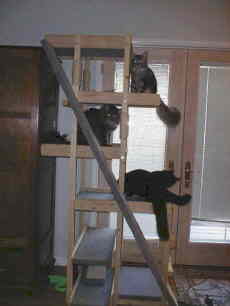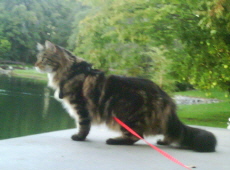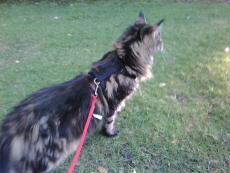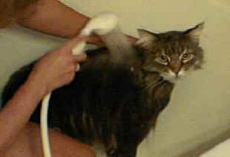
Windwalker Maine Coon Cats
Care and Feeding
| Home | Boys | Girls | Kittens | Why we love Maine Coons | Links | Hasta Luego | Email us |
A cat tree is an essential piece of furniture. From this one at our house, cats jump to the dresser, the armoire and over to another cat tree. |
 |
 |
Our cats know that a weekly nail trimming is a part of life and the scratching post is the place to scratch. Cats can easily be taught to scratch at a post (which should be big and sturdy enough to allow the cat to stretch to its full body length). We have cat trees several feet high placed next to windows, and the perches on these posts are one of the first places to look for a cat in our house. Cats can get gum disease so our cats have their teeth checked routinely at the vet, and will have their teeth cleaned by the vet when needed.
In the picture at left, Toto is very sure that he did not need a bath, but he's had them since he was little, so he stands quietly and endures.
|
A deficiency in one vitamin or mineral may leave your cat vulnerable to disease. A daily nutritional supplement provides your cat with the essential nutrients and immunity support it needs to live a long, healthy life. We use and recommend NuVet Plus for Felines vitamin powder. Click here to order online (if you sign up for autoship service you receive 15% off each order). You can also call to order, 1-800-474-7044, and give discount code 49057. |
| Food |
We believe high-quality food is extremely important to your cat's long, healthy life. Life's Abundance has no corn or wheat products, no artificial flavors or colors. To order Life's Abundance shipped to your home, click here. or call the toll-free order line, 1-877-387-4564. Be sure to give my ID #10026099 when calling. |
BeneBac. For intestinal distress. We order 15 gram tubes from Revival Animal Products and store them in the refrigerator. BeneBac is a source of live naturally occurring micro-organisms to help maintain the beneficial microbial population in the digestive tract. We just squirt a measured dose in their mouth. Wysong Pet Inoculant. This is magic stuff for intestinal problems. An orally dosed concentration of probiotic cultures and immunoglobulins, the probiotic cultures enhance healthy intestinal activity as well as combat and inhibit pathogenic E. coli bacteria. Each cc contains 200 million CFU of four bacterial species. Pet Inoculant is designed to be used in conjunction with antibiotic therapy and during any stressful condition. For intestinal distress, we sprinkle FortiFlora, a powder which comes in packets, on food. Or our cats love Wysong F-Biotic, a concentrated source of probiotic cultures, amino acids, fatty acids, enzymes, vitamins, inorganic, chelated and composted minerals and nutrients . Either is especially important if cats have been on antibiotics or have had any digestive problems. For vomiting, try some Aloe Vera Juice (without Sodium Benzoate), liquid chlorophyll and filtered water. Give it with a feeding syringe or dropper for digestive upsets, both stomach and intestinal. |
| Water |
Cats in the wild get water from their prey, but when they eat dry food, they metabolize food differently, and then they don’t drink enough water. We’ve found that FreshFlow water fountains encourage drinking water. It is very important to provide spring water or filtered water -- not tap water. |
| Vaccinations |
We vaccinate our kittens against upper respiratory viruses at nine and twelve weeks and they need one more one year after their last kitten vaccination. In 2015 the American Association of Feline Practitioners and the Academy of Feline Medicine recommended a change in vaccine protocol: no vaccines are necessary once a cat has had a vaccination after it is six months old. So a "booster"at one year old is sufficient to give immunity for life. Most veterinarian schools now recognize that one "booster" vaccination one year after their last kitten vaccination provides lifetime immunity, and many veterinarians agree that over-vaccinating our cats assaults their natural immune system, making it unable to deal with viruses and environmental toxins. As for rabies vaccinations, the American Association of Feline Practitioners and the Academy of Feline Medicine recommends that you only vaccinate to the minimum legal mandates required by state and local legislation. We agree with this. If you feel you must vaccinate against rabies, please give the rabies vaccination at a separate time from other vaccinations. We give a rabies vaccination to cats that will go to cat shows or to another cattery for breeding. We wait until they're a year old and make sure the vet notes that as a 3-year rabies vaccination. They're old enough at that age that the immunization will hold and they don't need it again. We do NOT recommend vaccinating your cat against feline leukemia and FIP since your cat will not be exposed to the outside and to other cats that may carry the diseases, there is no reason to subject your cat to unnecessary inoculations. Your Windwalker health guarantee will become null and VOID if you let your vet talk you into giving your cat these vaccinations. |
| Litter |
Although it costs more than other litters, World's Best Cat Litter lasts longer, smells less, and your house doesn't get dusty from it. We send some with your kitten, and if you decide to change to a different litter, do so gradually over one to two weeks or you may have problems. Start with mostly World’s Best and add a little bit of the new product so your cat can get used to the new material. Note: Don't make more than one change at a time, such as changing litter and brand of food at the same time. Too much change at once can produce excess stress and problems. WARNING: PLEASE DO NOT USE CLAY CLUMPING LITTERS! Clay clumping litters are hazardous to the health of longhaired cats such as Maine Coons that have “toe tufts” and feathery britches. When your cat cleans its feet or britches, clay clumping litter may settle and harden in the intestines and create deadly blockages. Litter Pan Preparation and Maintenance. Baking soda and other odor additives are BAD and baking soda is the worst. In addition to being VERY chemically active, it is a strong alkali and will cancel the natural acidic pH of the cat's urine and make it alkaline. Cats need acid pH so they do not get urinary crystals. This is especially important for neutered male cats. Baking soda is extremely dangerous to eat raw, it will chemically burn the digestive tract if cats lick it off their feet or britches. Litter manufacturers claim to add baking soda to supposedly cancel odors. However, odor is not a problem with the litter we use. Of course, we scoop the pans constantly. You'll notice that scooping the pans is a clear invitation to use them, (in fact, that's how we encourage elimination before a road trip), so you may often scoop again right after you've done it. When cleaning litter pans, use a good cleaner/disinfectant such as Simple Solution, Simple Green or similar products that kill bacteria. We recommend a “jumbo” size litter pan, without a hood, for your Maine Coon cat. It may seem extremely large at first, particularly for a kitten, but in time you will be thankful you got the largest size pan available. We actually use the dog training pans found at PetCo, or the long plastic boxes from office supply stores. (Our larger cats sometimes think they're in the box, and yes, their four feet are...) Add litter to about 3 to 4 inches deep. We also recommend that you put a bathroom rug around the litter pan to help control tracking of litter. Finally, to avoid problems, it's a good idea to have at least one more litter pan than you have adult cats. (For two cats, have three litter pans.) |
| Elimination Problems |
If your kitten or cat starts eliminating in inappropriate places, first take him or her to your vet for a comprehensive physical examination. If there are no physical reasons, think about what has changed in your cat's life: a new baby in the house, a new kitten? Social interactions between cats can often be the reason a cat starts marking or not using the litterbox. Then, consider the litterbox. Litterbox aversion is a common cause of inappropriate toileting. Cats are known for their fastidious nature. If the litterbox is dirty, cats will often choose another, cleaner, spot to eliminate. Each cat will tolerate a different level of litterbox cleanliness. If you suspect litterbox aversion, the litterbox should be kept scrupulously clean. In addition to litterbox cleanliness, other aspects of the litterbox environment can result in litterbox aversion including the location of the box, the style of the box and the brand of litter. Your vet will have suggestions. Sometimes, the vet has prescribed Prozac. Before you think "oh no, I'm never putting my cat on Prozac," consider these facts: More cats are euthanized for inappropriate elimination than any other reason, (better calm and happy than dead). You are not alone. Look at the shelf space given to gallons of Enzymatic solution for urine smell and stain at the pet stores. Urine marking is considered a normal communication behavior in both male and female cats. However, we consider it unacceptable in our homes. |
Helpful hints to keep your cat happy and healthy during the holiday season. - Don't use tinsel on your tree! Decorate your tree with animal safe ornaments such as dried non-toxic flowers, wood, fabric or pinecones. If ingested, ribbons or tinsel can become lodged in the intestines and cause intestinal obstruction. This is a very common problem with kittens. Keep aluminum foil and cellophane candy wrappers away from pets. They can cause vomiting and intestinal blockage. - Be careful with holiday floral arrangements. Common Yuletide plants such as mistletoe and holly berries can be toxic to cats. If your cat eats mistletoe, he or she could suffer gastrointestinal upset and cardiovascular problems. Holly can cause vomiting, nausea, diarrhea and lethargy if ingested. Poinsettias are considered to be very low in toxicity, however, they could cause mild vomiting or nausea if ingested by your cat. - Christmas tree water may contain dangerous fertilizers, which if ingested, can cause stomach upset. Stagnant tree water can also act as a breeding ground for bacteria and if ingested your cat could end up with nausea and diarrhea. Chocolate poisoning does not seem to be a problem in cats, although it could be possible if enough is ingested. - Boiled or grilled meats can be offered as a healthy alternative, but don't give pets holiday leftovers and use tightly-covered garbage containers. Cooked poultry bones can splinter and cause blockages. Greasy, spicy and fatty for spoiled foods can cause stomach upset and moldy foods could cause tremors or seizures. Older cats have more delicate digestive systems and nutritional requirements, so it's best to keep them on their normal diet. Any change of diet, even for one meal, may give them severe indigestion and diarrhea. - Alcohol and pets do NOT mix. Place unattended alcoholic drinks where pets cannot reach them. If your cat drinks it, he or she could become very sick and weak and may go into a coma. |
| What would you do if you had to evacuate |
We all need a disaster plan. Neighborhood and community groups and city fire departments offer classes so you can develop a plan for your family, and pets are often part of the plan. Whether you must evacuate or shelter in place, you're supposed to plan on having what you'll need for three days, and assume no utilities (including water). - The "blue bags" from Ikea a great for organizing items that you might need to "grab and go" quickly -- they are about $2 each, very sturdy and hold a large amount (they are "square" at the bottom, so they pack like a box or a bin, but are more flexible than a box so are easier to stuff into a car or van). The pre-packed bags are on shelves in the garage next to the door, so they are easy to "grab and go". They contain the following items: - 12 disposable litter pans Hopefully this list will help you get organized, as it is very, very important to have a plan in place. Our camper van is our emergency escape vehicle, so much of what WE need is already in it. |
|
Meat is high in phosphorus and it's very important to maintain a balance of calcium to phosphorus. Also, chicken and beef are low in Taurine, an essential amino acid for cats. Rodents have two to four times as much Taurine as beef or other meat, and cats on the docks and in the barns ate so many mice and rats over the years that they lost their ability to synthesize Taurine from other amino acids. Read any prepared cat food label and you will see Taurine has been added because Taurine deficiency has been identified as a cause of one form of heart disease in cats. |
| DISCLAIMER The information on this website is NOT intended to replace the advice of a Veterinarian. If your cat is displaying symptoms of illness or discomfort, seek the medical advice of a Veterinarian IMMEDIATELY. Windwalker Maine Coon Cats accepts no responsibility for the accuracy and content of the information provided by this website. |
![]()
Copyright © 2023 Windwalker Maine Coons - All rights reserved. | Updated 9/27/23 | Contact Us

 The Maine Coon coat is long and shaggy with a natural oiliness to repel water (helped when they were out in the barns and woods). They are a very "low-maintenance" cat, but we bathe them when they look oily.
The Maine Coon coat is long and shaggy with a natural oiliness to repel water (helped when they were out in the barns and woods). They are a very "low-maintenance" cat, but we bathe them when they look oily. Cats are extremely clean animals. and will only use a “clean” litter pan. If you aren’t meticulous about your litter pan maintenance, you may have problems, (urinating or defecating outside the litter box). Once this starts it can be difficult to correct.
Cats are extremely clean animals. and will only use a “clean” litter pan. If you aren’t meticulous about your litter pan maintenance, you may have problems, (urinating or defecating outside the litter box). Once this starts it can be difficult to correct.